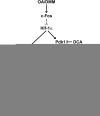Metabolic rewiring controlled by c-Fos governs cartilage integrity in osteoarthritis
- PMID: 37344157
- PMCID: PMC10423482
- DOI: 10.1136/ard-2023-224002
Metabolic rewiring controlled by c-Fos governs cartilage integrity in osteoarthritis
Abstract
Objectives: The activator protein-1 (AP-1) transcription factor component c-Fos regulates chondrocyte proliferation and differentiation, but its involvement in osteoarthritis (OA) has not been functionally assessed.
Methods: c-Fos expression was evaluated by immunohistochemistry on articular cartilage sections from patients with OA and mice subjected to the destabilisation of the medial meniscus (DMM) model of OA. Cartilage-specific c-Fos knockout (c-FosΔCh) mice were generated by crossing c-fosfl/fl to Col2a1-CreERT mice. Articular cartilage was evaluated by histology, immunohistochemistry, RNA sequencing (RNA-seq), quantitative reverse transcription PCR (qRT-PCR) and in situ metabolic enzyme assays. The effect of dichloroacetic acid (DCA), an inhibitor of pyruvate dehydrogenase kinase (Pdk), was assessed in c-FosΔCh mice subjected to DMM.
Results: FOS-positive chondrocytes were increased in human and murine OA cartilage during disease progression. Compared with c-FosWT mice, c-FosΔCh mice exhibited exacerbated DMM-induced cartilage destruction. Chondrocytes lacking c-Fos proliferate less, have shorter collagen fibres and reduced cartilage matrix. Comparative RNA-seq revealed a prominent anaerobic glycolysis gene expression signature. Consistently decreased pyruvate dehydrogenase (Pdh) and elevated lactate dehydrogenase (Ldh) enzymatic activities were measured in situ, which are likely due to higher expression of hypoxia-inducible factor-1α, Ldha, and Pdk1 in chondrocytes. In vivo treatment of c-FosΔCh mice with DCA restored Pdh/Ldh activity, chondrocyte proliferation, collagen biosynthesis and decreased cartilage damage after DMM, thereby reverting the deleterious effects of c-Fos inactivation.
Conclusions: c-Fos modulates cellular bioenergetics in chondrocytes by balancing pyruvate flux between anaerobic glycolysis and the tricarboxylic acid cycle in response to OA signals. We identify a novel metabolic adaptation of chondrocytes controlled by c-Fos-containing AP-1 dimers that could be therapeutically relevant.
Keywords: Arthritis, Experimental; Chondrocytes; Osteoarthritis.
© Author(s) (or their employer(s)) 2023. Re-use permitted under CC BY-NC. No commercial re-use. See rights and permissions. Published by BMJ.
Conflict of interest statement
Competing interests: None declared.
Figures







References
-
- Ayral X, Pickering EH, Woodworth TG, et al. . Synovitis: A potential predictive factor of structural progression of medial Tibiofemoral knee osteoarthritis - results of a 1 year longitudinal Arthroscopic study in 422 patients. Osteoarthritis and Cartilage 2005;13:361–7. 10.1016/j.joca.2005.01.005 - DOI - PubMed
Publication types
MeSH terms
Substances
LinkOut - more resources
Full Text Sources
Medical
Molecular Biology Databases
Research Materials
Miscellaneous

